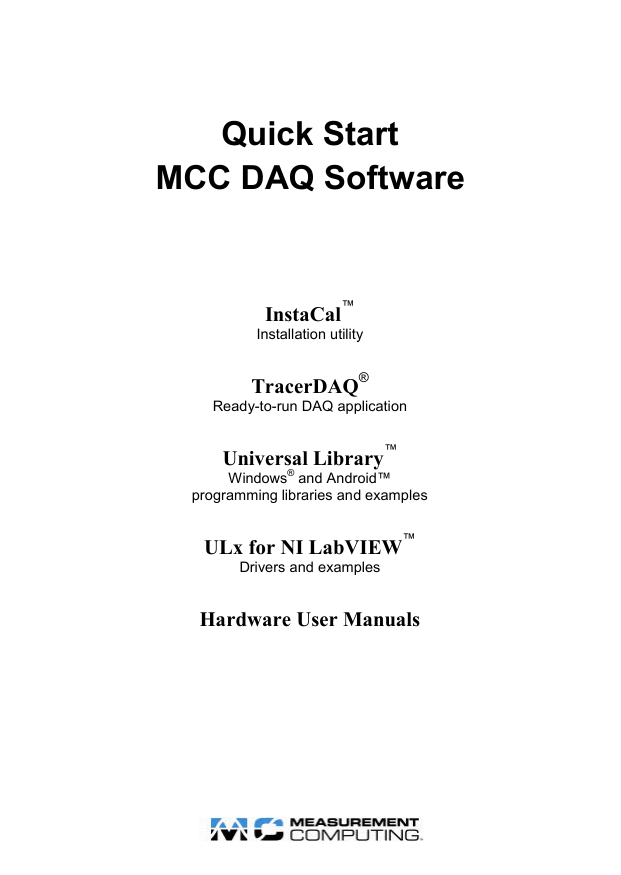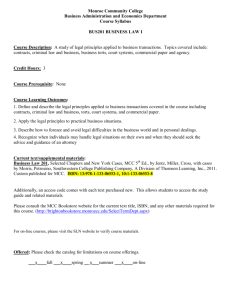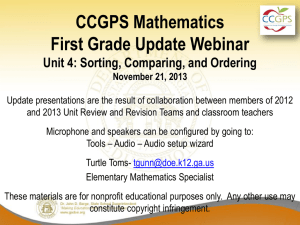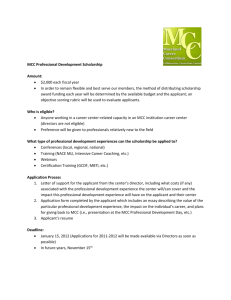
Quick Start
MCC DAQ Software
InstaCal
™
Installation utility
TracerDAQ
®
Ready-to-run DAQ application
Universal Library
™
®
Windows and Android™
programming libraries and examples
™
ULx for NI LabVIEW
Drivers and examples
Hardware User Manuals
Table of Contents
Getting Started with MCC DAQ Software ...................................................................4
Install the MCC DAQ Software and Hardware ............................................................4
Getting Started with InstaCal .......................................................................................5
Adding a Device ...................................................................................................5
USB, Bluetooth, WEB, and PCI Devices .........................................................5
Ethernet and Other Devices .............................................................................5
Configuring a Device ...........................................................................................5
Testing a Device ...................................................................................................6
Calibrating a Device .............................................................................................6
Getting Started with the Universal Library (UL) ..................................................6
Getting Started with the UL for Android .........................................................7
Getting Started with ULx for NI LabVIEW .................................................................7
Getting Started with TracerDAQ .................................................................................8
MCC Hardware User's Guides and Data Sheets ...........................................................9
For More Information ................................................................................................10
InstaCal ..............................................................................................................10
Universal Library ...............................................................................................10
ULx for NI LabVIEW ........................................................................................10
TracerDAQ help .................................................................................................10
Trademark and Copyright Information.......................................................................11
Notice .................................................................................................................11
3
Getting Started with MCC DAQ Software
Getting Started with MCC DAQ Software
Please read this booklet completely before you install your Measurement
Computing Corporation (MCC) software or device.
You can install MCC DAQ Software from the CD on a computer running
Windows 10/8/7/Vista/XP * (32- or 64-bit).
ISA, PC-CARD/PCMCIA and E-PDISO16 devices are only supported on
Windows XP.
MCC USB, Bluetooth®, Ethernet™, WLS, WEB, and most PCI devices
are supported on 64-bit Windows operating systems †.
Install the MCC DAQ Software and Hardware
To install the MCC DAQ software, complete the following steps:
1. Insert the installation CD and wait for the setup program to start.
All software packages are selected for installation if the requirements for
the package are met.
2. Click Install and follow the instructions to install each software package.
Each selected software package is installed one after the other using
separate installers, so make sure each installer finishes completely.
3. Install your device by following the instructions in the hardware user's
guide so that it gets detected by Windows ‡.
Note: Refer to www.mccdaq.com/software.aspx to download and install
the latest updates to the MCC DAQ software.
*
ISA and PC104 devices are only supported by Windows XP.
PCI-DAS1000 Series, PCI-DAS1200 Series, and PCI-DAS1600 Series devices are not
supported on 64-bit operating systems.
‡
Some MCC devices – such as USB-2500 Series or USB-2404 Series – display an
additional prompt while installing. This wizard is required to install additional drivers
specific to this device. Do not cancel this wizard or the device will not install properly.
†
4
Getting Started with InstaCal
Getting Started with InstaCal
InstaCal is a software utility for installing, configuring, testing, and
calibrating MCC devices. Running a supported Windows operating system
is the only requirement for installing InstaCal.
Adding a Device
Once you launch InstaCal, how you add your device to depends on the type
of bus interface.
USB, Bluetooth, WEB, and PCI Devices
These device types are automatically detected by InstaCal, which prompts
you to add the device to the InstaCal board list.
Select the devices to add to InstaCal on the Plug and Play Board
Detection dialog box and click OK.
Ethernet and Other Devices
Complete the following steps to manually add these types of devices to
InstaCal after they are connected to the computer or network.
1. Select Install»Add Board to display a group of tabs.
2. Click on the tab that corresponds to the type of device you want to install.
3. Select the device and click Add.
Each added device is listed on the PC Board List.
Configuring a Device
To configure a device with InstaCal, complete the following steps:
1. Select the device on the PC Board List and then select
Install»Configure.
2. Configure the device and click OK.
InstaCal stores hardware configuration settings in a configuration file which
is read by other MCC DAQ software when you run an application.
5
Getting Started with InstaCal
Note: Only one application program that calls the Measurement
Computing driver can be running at a time. If the device is used
by a Universal Library program, changes to device configuration
settings can only be made when the program is not running.
Testing a Device
The tests available with InstaCal depend on the features of the device.
If the device samples analog signals, select Test»Analog and follow the
onscreen instructions to perform analog input tests such as a loopback test
and a Scan test.
If the device samples digital signals, select Test»Digital. to perform
digital I/O tests such as an external DI test, an external DO test, an
internal CTR test, and an external CTR test.
Calibrating a Device
If your device supports field calibration, complete the following steps to
calibrate it with InstaCal:
1. Select the device on the PC Board List and the select Calibrate»A/D or
Calibrate»D/A.
2. Follow the onscreen instructions to calibrate the channels.
Getting Started with the Universal Library (UL)
The UL is an application development programming library for MCC
devices that requires one or more of these development languages:
Microsoft Windows languages: Visual Basic and Visual C/C++
.NET languages: VB .NET, C# .NET (Visual Studio® 2005 and later)
Android languages: Java (Android Studio, Eclipse™)
Most UL users detect and configure their hardware with InstaCal.
The UL API also includes functions and methods for detecting many types
of MCC devices at runtime. You can use these features in addition to or
instead of using InstaCal for detection and configuration.
6
Getting Started with ULx for NI LabVIEW
UL example programs are installed by default to
Users\Public\Documents\Measurement Computing\DAQ for
Windows OS except Windows XP. On Windows XP, the example programs
are installed to Program Files\Measurement Computing\DAQ.
When you install the example programs, an Examples shortcut is added to
the directory where you installed the UL. When selected, the directory
containing the example programs opens in Windows Explorer.
Note: Most UL example programs use API functions and methods to
detect and configure hardware.
Getting Started with the UL for Android
UL for Android is an API library for supported MCC DAQ devices that
support the Android platform. You can develop on supported Windows
platforms and deploy to Android devices using integrated development
environments such as Eclipse or Android Studio
Visit www.mccdaq.com/ULforAndroid for a list of DAQ devices supported
by UL for Android, or to download the UL for Android software to develop
Android apps on a Linux or Mac platform.
Select Android Examples to install example projects on Windows
platforms to deploy and run on an Android device. Refer to the UL for
Android Example Projects help topic in the UL for Android help to learn
how to deploy and run example projects on an Android device.
Getting Started with ULx for NI LabVIEW
ULx for NI LabVIEW is a library of virtual instruments (VIs) and example
programs used with National Instruments LabVIEW that requires the
following software:
InstaCal and UL
NI LabVIEW 2010 or later
Microsoft .NET Framework 2.0
7
Getting Started with TracerDAQ
MCC devices must first be detected and added to the InstaCal configuration
file before they can be used with ULx for NI LabVIEW.
You can open a ULx for NI LabVIEW example program from its default
installation directory (Program Files\National
Instruments\LabVIEW <version>\examples\ULx) or with the NI
Example Finder utility in NI LabVIEW.
Refer to the www.mccdaq.com/PDFs/manuals/QS ULx for NI
LabVIEW.pdf for a quick start example.
Getting Started with TracerDAQ
TracerDAQ is a virtual instrument application suite with strip chart,
oscilloscope, function generator, and rate generator that requires the
following software:
Microsoft .NET® Framework 2.0 (installs automatically)
DirectX 9.0c (installs automatically)
InstaCal
TracerDAQ requires the following hardware:
Video card with 16 MB of memory and support for Direct3D
Acceleration
Minimum screen resolution of 1024 × 768
Computer with Pentium® 4 processor and 256 MB of RAM
A Microsoft-compatible mouse
Supported MCC DAQ device
MCC devices must first be detected and added to the InstaCal configuration
file before they can be used with TracerDAQ.
Refer to the TracerDAQ Help (TracerDAQHelp.chm) for quick start
examples of each TracerDAQ application – strip chart/data logger,
oscilloscope, function generator, and rate generator.
8
MCC Hardware User's Guides and Data Sheets
MCC Hardware User's Guides and Data Sheets
You can view and download the latest hardware user's guides from
www.mccdaq.com/manuals.aspx, and the latest product data sheets are
available at www.mccdaq.com/specs.aspx.
If you installed the MCC hardware user's guides, run InstaCal and select
Help»User's Guides. Brows the folders to find your hardware user's guide.
Adobe® Reader® is installed with the user's guides if it is not already
installed on the computer.
9
For More Information
For More Information
If you have questions that you cannot answer by reading this booklet, refer
to these resources:
Knowledgebase: kb.mccdaq.com
Tech support form at www.mccdaq.com/support/support_form.aspx
Email: techsupport@mccdaq.com
Phone: 508-946-5100 and follow the instructions for reaching
Tech Support.
Customers outside of the U.S. should contact their local MCC distributor for
support. Refer to www.mccdaq.com/International to locate a distributor.
InstaCal
For more information about InstaCal, refer to the readme files in the
\ICalUL folder on the MCC DAQ Software CD.
Universal Library
For more information about UL, refer to the Universal Library Help
(ULHelp.chm). Use the Search tab in the help file to find information
about the UL functions that your device supports.
For more information about UL for Android, refer to the UL for Android
help files in Program Files\Measurement
Computing\DAQ\Android\ul_help.zip.
ULx for NI LabVIEW
For more information about ULx for NI LabVIEW, refer to the ULx for
NI LabVIEW Help (lvulx.chm).
TracerDAQ help
For more information about TracerDAQ, refer to the TracerDAQ Help
(TracerDAQHelp.chm).
10
Trademark and Copyright Information
Measurement Computing Corporation, InstaCal, Universal Library,
TracerDAQ, and the Measurement Computing logo are either
trademarks or registered trademarks of Measurement Computing
Corporation. Refer to the Copyrights & Trademarks section on
mccdaq.com/legal for more information about Measurement Computing
trademarks. Other product and company names mentioned herein are
trademarks or trade names of their respective companies.
© 2015 Measurement Computing Corporation. All rights reserved. No
part of this publication may be reproduced, stored in a retrieval system,
or transmitted, in any form by any means, electronic, mechanical, by
photocopying, recording, or otherwise without the prior written
permission of Measurement Computing Corporation.
Notice
Measurement Computing Corporation does not authorize any
Measurement Computing Corporation product for use in life support
systems and/or devices without prior written consent from Measurement
Computing Corporation. Life support devices/systems are devices or
systems that, a) are intended for surgical implantation into the body, or
b) support or sustain life and whose failure to perform can be reasonably
expected to result in injury. Measurement Computing Corporation
products are not designed with the components required, and are not
subject to the testing required to ensure a level of reliability suitable for
the treatment and diagnosis of people.
Measurement Computing Corporation
10 Commerce Way
Norton, Massachusetts 02766
(508) 946-5100
info@mccdaq.com
www.mccdaq.com
*324255M-01*
324255M-01
SM MCC_DAQ_Software.docx
Nov15
Rev21





